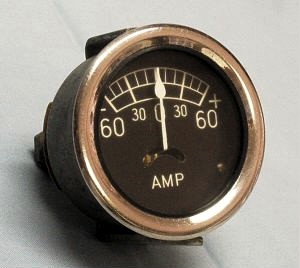

|

|
The very first ammeters to find their way onto the panel of automobiles
didn't look much different than this feller. The instrument shown is an example
of the classic "Battery Ammeter" . . . it has a zero-center scale with minus readings
(discharging) to the left and plus reading (charging) to the right. This particular
instrument has a full scale calibration of 60 amps. Many battery ammeters in automobiles
had no particular calibration marks . . . my first automobile, a 1941 Pontiac coupe
had a simple (-) zero (+) display with no calibration. The generator on this car was
a 20A machine so I suspect that if the ammeter had been calibrated, a 30-0-30 or
even 20-0-20 marking would have been appropriate.
|
|
The very first ammeters to find their way onto the panel of automobiles
didn't look much different than this feller. The instrument shown is an example
of the classic "Battery Ammeter" . . . it has a zero-center scale with minus readings
(discharging) to the left and plus reading (charging) to the right. This particular
instrument has a full scale calibration of 60 amps. Many battery ammeters in automobiles
had no particular calibration marks . . . my first automobile, a 1941 Pontiac coupe
had a simple (-) zero (+) display with no calibration. The generator on this car was
a 20A machine so I suspect that if the ammeter had been calibrated, a 30-0-30 or
even 20-0-20 marking would have been appropriate.
|

|

|
The very first ammeters to find their way onto the panel of automobiles
didn't look much different than this feller. The instrument shown is an example
of the classic "Battery Ammeter" . . . it has a zero-center scale with minus readings
(discharging) to the left and plus reading (charging) to the right. This particular
instrument has a full scale calibration of 60 amps. Many battery ammeters in automobiles
had no particular calibration marks . . . my first automobile, a 1941 Pontiac coupe
had a simple (-) zero (+) display with no calibration. The generator on this car was
a 20A machine so I suspect that if the ammeter had been calibrated, a 30-0-30 or
even 20-0-20 marking would have been appropriate.
|
|
The very first ammeters to find their way onto the panel of automobiles
didn't look much different than this feller. The instrument shown is an example
of the classic "Battery Ammeter" . . . it has a zero-center scale with minus readings
(discharging) to the left and plus reading (charging) to the right. This particular
instrument has a full scale calibration of 60 amps. Many battery ammeters in automobiles
had no particular calibration marks . . . my first automobile, a 1941 Pontiac coupe
had a simple (-) zero (+) display with no calibration. The generator on this car was
a 20A machine so I suspect that if the ammeter had been calibrated, a 30-0-30 or
even 20-0-20 marking would have been appropriate.
|

|
 Click here to contact Bob at AeroElectric Connection Click here to contact Bob at AeroElectric Connection |